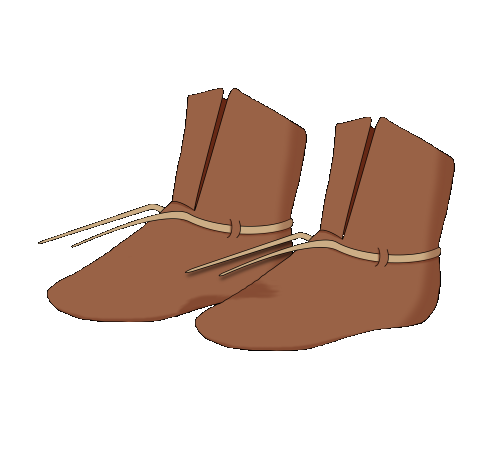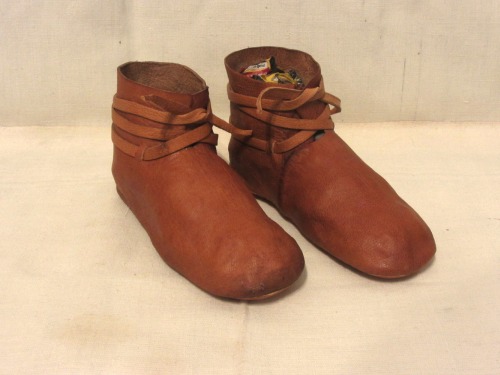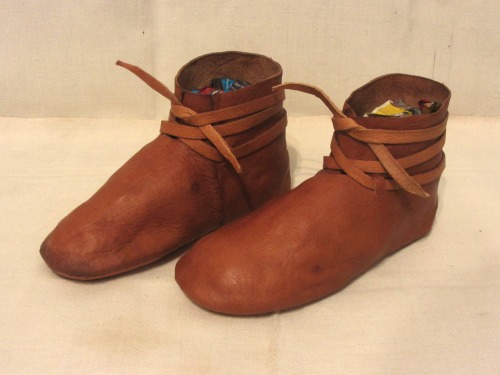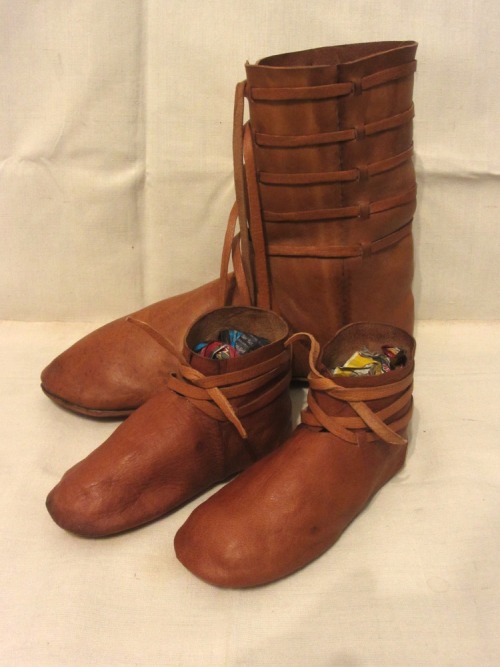Our son is now old enough to join us on the events, therefore he needs his own equipement and clothing. I’ve also been interested in how long it takes to make a pair of childs shoes. So, this was the perfect timing.
I was planning to make a simple par of type “Lübeck” (Volken, Marquita 2014, p. 507), shoes which have been in use between the mid of the 12th century till the 15th century. This type is a simple ankle shoe with lace-fastening like shown in the following picture. It is often found all over Europe. For example in Schleswig (Schnack 1992), Lübeck, Konstanz (Schnack 1994), Svendborg (Groenman 1988), Dordrecht (Goubitz und van Driel-Murray und Groenman-van Waateringe).

Draft of a type "Lübeck" ankle-shoe with lace fastening
The lace could be fastened in 3 different ways
- Two pairs of vertical slits on the sides of the shoe to pass the lace through
- Two straps which are drawn through horizontal slits and form a pair of loops to hold the lace (Goubitz und van Driel-Murray und Groenman-van Waateringe, p. 140 Abb. 11])
- No slits at all. The lace was just wound arround the foot
Cause I did not want to lose the laces all the time and replace them I choose the 1 version.
The vamp is cut in one piece and often has a square insert on the medial side of the foot to achieve the necessary height. The opening is in front of the shin. The flaps next to the opening do not overlap at all, or if they do not too much. The opening can be straight or raised at the tip. Reinforcements at the heel can be found but are not to common at the childs size shoe finds.
For this pair I used natural coloured and vegetable tanned goat leather for the upper and a 2.5mm thick cow leather for the sole. I choose to add a reinforcement at the heel, but made it out of sheep leather. So it should be flexible enough.
Thats how the finished pair looks like. The size is about an european size 26.

Finished pair of childs turnshoes made out of goat leather

Other side of finished pair of childs turnshoes made out of goat leather
If you look at these shoes on their own one could think that they are some clunky pair of adults shoes. But if you put them next to a size 42 pair of shoes one recognizes how small they are.

Compare the size of the childs shoes next to a pair of size 42 shoes
Unfortunately my son is growing to fast and therefore the shoes became too small before he could really use them. Therefore I gave them to another family with a young child and hope they will be happy with these pair (and that they last a little longer).
Sources
- Goubitz, Olaf; van Driel-Murray, Carol; Groenman-van Waateringe, Willy (2001): Stepping through time. Archaeological footwear from prehistoric times until 1800. Zwolle: Stichting Promotie Archeologie.
- Groenman-van Waateringe, Willy (1988): Leather from medieval Svendborg. Odense: University Press (The Archaeology of Svendborg, Denmark, 5).
- Schnack, Christiane (1992): Die mittelalterliche Schuhe aus Schleswig. Ausgrabung Schild 1971-1975. Neumünster: Wachholtz (Ausgrabungen in Schleswig, 10).
- Schnack, Christiane (1994): Mittelalterliche Lederfunde aus Konstanz. Grabung Fischmarkt. Stuttgart: Theiss (Materialhefte zur Archäologie in Baden-Württemberg, 26).
- Volken, Marquita (2014): Archaeological footwear. Development of shoe patterns and styles from prehistory till the 1600’s. Univ., Lausanne–Zwolle, 2012. Zwolle: Stichting Promotie Archeologie.
 Adalbert Shouster
Adalbert Shouster

